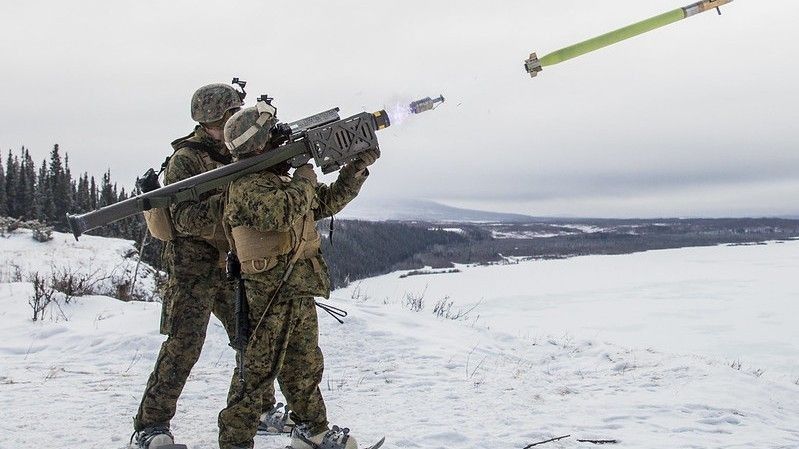Germany Acquires Stinger MANPADS. Costly Replenishment of Military Aid to Ukraine

Photo. Cpl. Sean Evans/Alaskan NORAD
DSCA approved delivery of the Stinger missiles for three European nations: Germany, the Netherlands, and Italy. The procurement is handled via NATO NSPA. In the case of the two former states, the delivery is probably caused by a need to replenish the stockpiles, after some equipment was handed over to Ukraine. The US-made MANPADS is relatively expensive, compared to the Polish Piorun system for instance.
As the release issued by DSCA states, approval was granted for the procurement of 940 FIM-92K Stinger Block 1 missiles. Apart from them, the package with a price tag of USD 780 million also includes battery cooling systems, metal containers, and support granted by the US government.
The release stresses the fact that the finalization of the contract is aligned with the goals of the US national security policy, and systems would be used to defend the territories of the allies and strengthen regional stability. They would also remain interoperable with the US military assets. The transaction does not include the offset. Raytheon and Lockheed Martin are expected to act as the primary contractors.
It remains highly plausible that at least two out of three listed states (Germany and the Netherlands) are procuring the systems in question to replenish their stockpile after providing military aid to Ukraine. Germany transferred 500 Stinger missiles to Kyiv at the very start of the full-scale war (designated Fliegerfaust 2, and license-manufactured in Germany). The Netherlands transferred another 200 systems. Both nations operate the Stinger MANPADS and systems using Stinger as the primary weapon (Ozelot, Fennek Stinger). Germany is also planning to integrate the Stinger with the first lot of the Skyranger 30 system (based on the Boxer APC).
If the transaction is finalized once the agreements are concluded (Congress is being notified now), it would also influence the European shoulder-fired MANPADS market. It shows that more nations express their interest in the Stinger missiles, the manufacturing of which has been restarted, as a need emerged to replenish the stockpiles, once weapons had been supplied to Ukraine. Back in 2022, a contract was signed regarding 1,300 Stinger systems for the US Army, with a price tag of USD 624 million.
At the same time, Poland procured 3.5 thousand Mesko Piorun MANPADS, plus 600 launch units, for PLN 3.5 billion (gross, VAT included). The Polish missiles are less expensive then, while the Ukrainian experience has shown their proven lethality. The Polish industry is also working on enhancing the Piorun MANPADS, so far with the use of own funds, as no formal R&D project was assigned within that regard - and this is necessary to deploy a new generation of the Piorun MANPADS.
Piorun has become quite an export hit as well. Before the full-scale war in Ukraine broke out the missiles had been procured by the United States, and just recently Norway made a procurement (where Piorun outclassed some of its NATO competing bids, from Sweden, USA, and France, in an open tender), along with Estonia, Latvia, and an unspecified user in the Balkans. A preliminary selection of Piorun has also been made by Slovakia, in its VSHORAD tender. The Polish MANPADS manufacturing capabilities are also being enhanced. More than 1,000 systems are to be manufactured over the upcoming 12 months. The manufacturing is happening at a pace faster than the one associated with Stingers - earlier, the releases had suggested 60 Stinger missiles would be manufactured per month until 2025 (700-750 per year).
The Americans aggressively market Stinger, using the experience gathered during Stinger use in countries that have been operating this system for years now. Recently, an R&D project was started, aimed at developing a next-generation MANPADS, with a maximum value of USD 700 million. This is 20 times more than the sum associated with the development of the Piorun system (prices valid for 2010). The Americans are also considering a potential transfer of Stinger manufacturing to one of the European states when a replacement is commissioned. It is worth noting that Poland remains virtually the only manufacturer of shoulder-fired MANPADS in the EU, among the NATO member states, and one of the two manufacturers of such a system in NATO overall (alongside the US). Other nations tend to focus on heavier VSHORAD solutions, not designed for shoulder-firing, but for tripod/vehicular use.
Read more
These include the Swedish RBS-70(NG), or the French Mistral systems. Interestingly, the Baltic states recognize the necessity to use systems of both classes. Lithuania was commissioning RBS-70 in parallel with the Grom MANPADS. Latvia, meanwhile, was doing the same thing, but in parallel with the Piorun system. Meanwhile, Estonia which procured Piorun MANPADS in 2022, still operates the French Mistral systems, procuring more as time goes by. This is yet another argument that supports further development of Piorun, not just in the form of MANPADS, but also in a new variant with a range of ca. 12 kilometers, developed in the Grzmot programme.
The Piorun system exemplifies the fact that the Polish defence industry can deliver high-quality PGMs at a lower price than Western competitors. Many symptoms suggest that there are many clear advantages of solutions offered by the Polish manufacturers here, that are also far more clear than the ones applicable to conventional artillery rounds procured from PGZ Group, within the framework of the National Munitions Reserve.
Thus, not only is it worth investing in procurement, but also in the growth of Polish competency, when it comes to smart munitions. That ensures gradual development of know-how and defence capabilities, with a good cost-effect ratio. This shall be remembered not just in the context of the development of the Piorun MANPADS. The aforesaid factors also remain relevant in the case of the Pirat ATGM, or APR Precision Guided Munitions for Krab and K9 howitzers. Once a relevant decision is made, these products could become as successful as Piorun was, ensuring sovereign capabilities for the Polish Armed Forces, at a cost much lower than the one associated with the procurement of such solutions from foreign partners.



